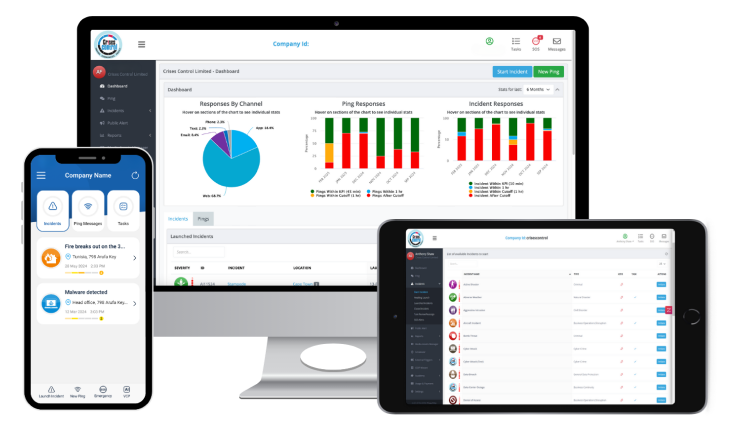Written by Anneri Fourie | Crises Control Executive
Imagine a key system in your business suddenly goes offline. Emails stop sending, orders cannot be processed, and teams are left unsure of what to do next. Even a short disruption like this can ripple across your operations, causing lost revenue, frustrated customers, and a scramble to prove compliance to regulators. Many organisations only realise their continuity plans are inadequate when they are already facing the disruption.
ISO 22301 Compliance Software exists to prevent these situations. It provides a structured approach for keeping critical operations running during an incident and ensures that organisations can meet the requirements of the ISO 22301 standard. This article will explain why ISO 22301 matters, the common challenges businesses face in achieving certification, and how tools like Crises Control help companies turn theory into practice.
What Is ISO 22301 and Why Is It Important?
ISO 22301 is the international standard for Business Continuity Management Systems. It sets out what organisations must do to remain operational during disruptive events. The standard focuses on identifying risks, establishing plans to maintain critical functions, keeping communication lines open, and regularly testing the effectiveness of those plans.
Achieving ISO 22301 certification is not just about having a documented plan. Organisations need to provide evidence that they can respond effectively in real scenarios. Many struggle because manual systems do not capture all the necessary information, and teams often lack clarity on roles during an incident.
Statistics show that nearly half of businesses without a tested continuity plan fail within a year after experiencing a major disruption. ISO 22301 transforms this risk into an actionable plan, giving organisations the ability to continue operating while demonstrating compliance to auditors and regulators.
What Are the Common Challenges in Achieving ISO 22301 Certification?
Achieving ISO 22301 certification is not always straightforward. Businesses encounter several recurring obstacles:
- Fragmented Systems: Using spreadsheets, emails, and ad hoc phone calls to manage continuity plans slows down coordination and increases the chance of errors.
- Lack of Audit Trails: Auditors need clear evidence of planning, testing, and communication. Manual tracking often leaves gaps, creating extra work during audits.
- Slow Incident Response: Even with plans in place, delays in activating teams and sending instructions can worsen the impact of an incident.
- Inconsistent Testing: Regular drills are required to verify readiness. Many organisations perform them sporadically, and results are rarely documented properly.
- Ineffective Communication: Relying on a single method of communication can be risky. During a disruption, employees may not receive critical instructions in time.
These challenges make certification difficult and expose organisations to operational risks and reputational harm. Without the right tools, even well-intentioned teams can struggle to meet ISO 22301 requirements.
How ISO 22301 Compliance Software Solves These Problems
Technology changes the way businesses approach compliance and resilience. ISO 22301 Compliance Software automates processes, provides evidence for audits, and ensures teams can respond quickly and effectively. Crises Control is an example of software designed to address these challenges in a practical, usable way.
Key benefits include:
- Centralised Business Continuity Planning: All plans, workflows, and critical information are stored in one secure system. Teams know exactly where to find instructions during an incident, removing confusion and saving valuable time.
- Automated Audit Trails: Every action, message, and completed task is recorded automatically. This creates verifiable evidence that auditors can review without additional manual work.
- Emergency Notification System: Multi-channel communication, including email, SMS, voice calls, and app notifications, ensures messages reach all staff promptly.
- Crisis Management Workflows: Structured incident playbooks guide teams through response procedures step by step, reducing delays and uncertainty.
- Drill and Test Scheduling: Regular exercises can be scheduled, executed, and reported, helping organisations identify weaknesses and demonstrate readiness.
By automating these processes, software transforms compliance from a paperwork exercise into a practical, actionable system that prepares organisations for real-world disruptions.
Practical Steps to Achieve ISO 22301 Certification
Starting the journey towards ISO 22301 certification can feel overwhelming. Breaking it down into practical steps makes it manageable:
- Understand Your Risks: Carry out a Business Impact Analysis. Identify which functions are critical and consider the consequences if they are disrupted.
- Develop Your Plans: Assign responsibilities, define recovery procedures, and ensure necessary resources are available.
- Implement Technology Support: Use software that automates evidence collection, centralises information, and guides teams through responses. This approach reduces manual effort and ensures consistency.
- Test and Refine: Conduct scenario-based drills and update plans based on lessons learned. Document every exercise for audit purposes.
- Create a Culture of Continuity: Certification is not a one-time task. Organisations need ongoing training, leadership support, and a commitment to continuous improvement.
Automating step three in particular simplifies the process significantly. Without it, businesses often spend excessive time tracking manual logs and chasing emails. Software ensures that evidence and communication are ready when auditors request them.
The Role of Business Continuity Software with Audit Trails
One of the main obstacles during audits is proving that plans are effective. Business continuity software with audit trails solves this by logging every alert sent, task completed, and incident response performed.
This level of tracking gives auditors confidence and saves businesses time. At Crises Control, audit-ready reporting is built into the platform, ensuring that compliance evidence is always accurate, accessible, and easy to review. This eliminates the need for manual tracking and reduces stress during audits.
How Crisis Management Software Complements Continuity Planning
Disruptions rarely follow a script. Natural disasters, cyberattacks, or supply chain issues often require fast, coordinated action. Crisis Management Software supports teams in responding to such events:
- Teams can follow predefined crisis playbooks rather than improvising under pressure.
- Information can be shared securely in real time, reducing misunderstandings.
- Managers gain visibility of tasks, progress, and any gaps that need attention.
Integrating continuity and crisis management capabilities allows organisations to move from simple compliance towards true operational resilience.
How Crises Control Supports Organisations
Crises Control has been designed to support ISO standards from the outset. It offers practical tools that help businesses implement, test, and maintain their continuity plans:
- Multi-industry application: Used by organisations in finance, healthcare, manufacturing, and the public sector, adapting to a wide range of operational needs.
- Secure communication: End-to-end encrypted and GDPR-compliant, suitable for sensitive environments.
- Simple deployment: Cloud-based and scalable, allowing teams of all sizes to adopt and manage the platform effectively.
- Real-world outcomes: Clients report faster incident response, smoother audits, and improved confidence in continuity and resilience.
By addressing fragmented systems, missing evidence, and slow response times, Crises Control supports organisations in embedding ISO 22301 requirements into everyday operations. To see the standards and accreditations that Crises Control meets, visit our Accreditations page.
Conclusion: Real Preparedness Goes Beyond Certification
ISO 22301 certification is not simply an award to display. It is proof that an organisation is capable of maintaining critical operations when unexpected disruptions occur. However, certification alone is not enough. True preparedness comes from embedding these standards into daily practice and supporting them with technology that makes compliance achievable and measurable.
Crises Control helps organisations do this by combining business continuity planning, audit-ready reporting, an emergency notification system, and structured crisis management in a single platform.
When a disruption happens, the difference is not just the plan on paper but how effectively your teams can respond. Organisations that combine structured planning with practical tools are far more likely to maintain operations, protect their reputation, and demonstrate compliance to auditors.
Contact us today to request a free demo of Crises Control and see how our ISO 22301 Compliance Software can support your organisation in preparing for the unexpected.
Request a FREE Demo

